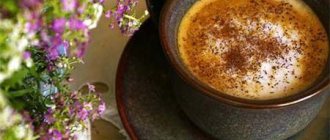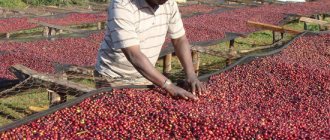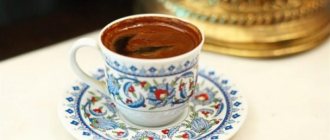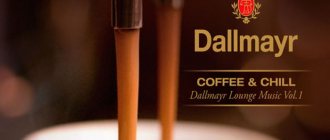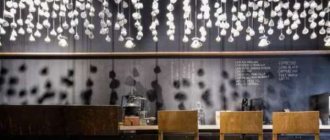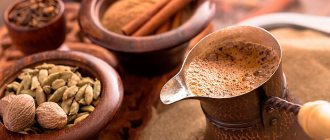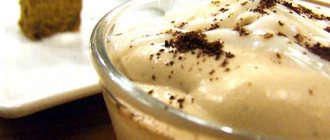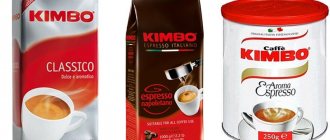Advantages and disadvantages of ceramic Turks.
The first Turks sculpted from clay, which was subsequently fired. An inexpensive category of cezves is metal and made of copper. The ceramic Turk came to replace it relatively recently. The popularity of ceramic models is deserved by their ease of maintenance and the possibility of repeated use for different types of coffee beans.
The basis for earthenware and ceramic dishes is clay. Subsequently, it is fired in a kiln. A clay Turk is not covered with enamel - this is its main difference from ceramics.
View this post on Instagram
Posted by Moonflower Tea Boutique (@moonflower113) Oct 8, 2020 at 12:35 pm PDT
The glassy glaze that coats the ceramic pot increases strength. The coating makes it easy to clean. Coffee brewed in a ceramic pot has a unique aroma and taste. The coating protects the clay from oxidation.
Ceramic cezve does not take away the aroma of the drink, therefore it is used for various varieties, unlike metal predecessors.
The disadvantage of ceramic cezves is fragility, slow heating and cooling. Preparing the drink requires close attention. Turning off the gas does not guarantee that the coffee will not boil over. The disadvantage of enameled clay is its high sensitivity to temperature fluctuations. Rinsing with cold water immediately after heating is not acceptable, as is careless handling.
The purchase price is not in favor of ceramic products. Metal analogues cost one and a half to two times less.
Materials for making a cezve
It is impossible to draw a clear conclusion which coffee pot is the best. Different manufacturing materials have both advantages and disadvantages, which affects the quality of not only the product itself, but also the drink prepared in it. Taking into account all the nuances, every coffee lover will be able to choose the best option for themselves.
Clay
A clay coffee pot is the choice of real gourmets. The specific structure of the material provides a special, deep and rich taste of the drink. Heat here spreads slowly and persists for a long time. This option is ideal for hot sand. At the same time, the clay absorbs the aroma of coffee. Accordingly, the same Turk is not suitable for different types of grains. Among the disadvantages, it is also worth highlighting the fragility of the material and the high probability of foam running off in such dishes.
Ceramics
The properties of ceramics are somewhat similar to clay. Such a Turk also ensures maximum development of the taste of the drink, and due to its thick walls it retains its heat for a long time. However, the material does not absorb the smell of beans. Ceramic cookware can be used to work with different types of coffee. Such properties are equivalent to the characteristics of copper, so it is very difficult to say which Turk is better - ceramic or copper. The main disadvantage is low strength - even the best and most expensive ceramic model is easy to break, so it requires careful handling.
Steel
Owners of induction cookers should choose a stainless steel pot. The material has pronounced ferromagnetic properties necessary for safe contact with a modern hob. In addition, it is very durable, which distinguishes such products from analogues made from other alloys. But the steel Turk is not the best for those who have a delicate taste for coffee. Due to low thermal conductivity, the liquid is heated unevenly, which negatively affects the quality of the drink.
Aluminum
If we rank the best materials for Turks, aluminum will definitely take one of the leading positions. In terms of quality, it is inferior to copper or brass, if only because it looks extremely unpresentable. But its cost is significantly lower than other alloys, which means that every fan of an invigorating drink can afford to purchase such a Turk. Advantages of aluminum products:
- ease of care;
- immunity to mechanical damage;
- safety;
- light weight.
The thermal conductivity of aluminum is half that of copper. But this is enough to heat the liquid evenly, which is why the taste of coffee from aluminum Turks is not inferior to drinks brewed in other traditional cezves.
Silver
A silver Turk is an expensive and elegant product that can decorate a classic interior. Only jewelry factories and private workshops work with precious materials. External decorative characteristics are the main and, perhaps, the only advantage. A Turk made of silver is impractical in everyday life. It produces watery coffee due to excessively rapid heating. In addition, the cost of such products is very high; other types of Turks will cost much less.
Cupronickel
Despite the fairly high quality of the material, such Turks are very rarely found on sale - and this is the only thing that can upset a potential buyer. Cupronickel is nothing more than an alloy of copper and nickel, so all the advantages of such products are almost identical to copper ones. A special feature is slightly lower thermal conductivity. Cupronickel Turks of classic shape perfectly preserve the taste and aroma of coffee. And the principle of preparing a drink on the stove is no different from the traditional one.
Brass
A brass pot has more advantages than disadvantages. The main reasons why many buyers choose it:
- high strength;
- reasonable cost;
- no need for specific care;
- preservation of the taste and aroma of coffee;
- aesthetic appearance.
The brass Turk must have a protective coating that will prevent the oxidation process. If the latter occurs, the product becomes unsuitable for further use.
A good, high-quality Turk is usually coated with food-grade tin.
Copper
The copper Turk is an unchanging classic. This material has always been in demand due to its large number of positive properties. The high level of thermal conductivity allows you to quickly but evenly heat the liquid. The prepared coffee has a rich taste and aroma. If we consider which pot is better - copper or stainless steel, the first one will certainly win. Its only drawback may be the lack of internal coating, but such models have long been rare in the range of modern products.
How to choose the right ceramic Turk
Before you start purchasing, decide on your wishes and requirements for the cezve. The quality of ceramic tableware is determined by a number of characteristics:
- Inspect the product upon purchase. Buy dishes in coffee shops, tea shops and online stores. The weak point of the product is the handle. The area connecting to the bowl is often the first to break. Some manufacturers, such as the Cerflame brand, offer models with a removable handle. If it breaks, you won't need to replace the casing. Scratches, chips, uneven coating are indicators of a low-quality product or improper storage.
- Volume. Ceramic cezve, designed for 1-3 cups of coffee, is popular. Keep in mind that heating the cezve takes a long time. The larger the volume, the longer this time.
- Form. The wide bottom of the ceramic Turk promotes uniform heating of the liquid. The classic shape is conical. The thicket settles faster to the bottom of the cone-shaped cezve.
History of the invention of the Turks
Information about the date of the first preparations has been lost for centuries, but the chronology of the emergence, development and improvement of the devices in which real coffee was prepared has been preserved.
There are two versions of the origin of the name of the cooking utensil.
- From the Arabic word جذوة (jadhwa), translated as “smoldering coals”, which sounds like “dzhezva” in Russian and means a forged copper ladle of a peculiar shape intended for brewing coffee.
- From the Turkish "Cezve" - coffee pot.
In our country, this kitchen utensil is called a Turk because of its purpose for brewing Turkish coffee.
Many people are interested in what are the differences between Turks and cezves? There is no difference - these are the same objects.
In our country, this kitchen utensil is called a Turk because of its purpose for brewing Turkish coffee.
When was the first Turk created?
Nomadic African tribes were the first to learn how to make coffee about a thousand years ago. They used copper and bronze utensils reminiscent of modern cauldrons, in which the drink was boiled over a fire.
The tradition was adopted from the Africans by the Bedouin nomads, who used irbiki for cooking - stable traveling jugs with a long neck and spout, closed with a lid. They held about 100 ml of liquid and were originally used for water.
Irbiks have been used for several centuries and are considered the first devices for making coffee.
Tribes leading a nomadic life began to populate the Arabian Peninsula, where eastern merchants became interested in the recipe, who considered the drink worthy of a ruler and delivered it to the Sultan, whose cooks began to cook it in a small golden saucepan with a lid and handle (so that no one’s breath would desecrate its divinity). But in such a vessel, coffee quickly heated up and often burned, so the ruler ordered it to be improved. The updated version was made of tinned copper, widened at the bottom and narrowed at the top and called “dalla”.
The updated version was made of tinned copper, widened at the bottom and narrowed at the top and called “dalla”.
Around the Sultan, a tradition arose of having conversations over a cup of coffee, this gave the drink popularity, and it spread among the rich. Later, metal dalls appeared for the poorer classes.
In 1554, coffee houses began to open in the Ottoman Empire, which were very popular. The people who gathered there gossiped and slandered the authorities, so they were soon converted into hairdressing salons, and coffee was banned. But lovers of the drink did not abandon it, but began to prepare it secretly.
European aristocrats adopted the recipe from the eastern inhabitants, the Russians from the Turks. Only the name “dzhezva” did not take root in our country, and as a result of mass distribution, its own name appeared – “Turk”.
European aristocrats adopted the recipe from the eastern inhabitants, the Russians from the Turks.
Shape Features
Modern cezves come in a variety of shapes, but most of them do not make better coffee. The most aromatic drink can still be obtained only by preparing it in a classic Turk, which has:
- An expansion into which a narrow neck passes, performing the function of trapping foam (the larger it is, the better);
- A narrowed neck helps prevent the evaporation of volatile esters, which give the drink a special taste and aroma;
- Conical shape ensures sedimentation of the grounds, minimal foaming and its concentration in the narrow part of the turk;
- The wide bottom promotes uniform heating of the dishes and the liquid contained in it.
True coffee connoisseurs know that choosing the right Turkish coffee is a guarantee of excellent taste and aroma.
True coffee connoisseurs know that choosing the right Turkish coffee is a guarantee of excellent taste and aroma.
Turk ceramic ceraflame
A good Turk is one of the components of aromatic coffee. The quality of the raw materials, functionality and appearance of the cookware are important. The Brazilian-made Ceraflame cezve will satisfy the wishes of anyone. The Certa Ceramica company offers several models with different colors, functional features and product prices.
View this post on Instagram
Posted by Turki for Coffee (@ceraflame.ukraine) March 3, 2020 at 1:00 PST
The brand offers four colors of cezves: black, dark chocolate, light brown and red. Step-by-step firing of clay Turks helps to achieve temperature resistance. Environmentally friendly materials make the product non-toxic to humans.
The average cost is 2500-3000 thousand rubles. Ceraflame Turks are made of high-quality materials, have thick walls and a sophisticated design.
Ceraflame ibriks with a hint of dark chocolate will fit perfectly into the interior of the Turk. The removable handle will make the ceramic easier to use and care for. The glaze of the product is less sensitive to temperature changes. It does not absorb odors and dirt.
View this post on Instagram
Posted by Ceraflame (@ceraflame) Feb 15, 2020 at 5:13 am PST
The price of an Ibriks cezve is approximately 2500 rubles. The buyer will need time to get used to cooking in it. Long heating and long cooling are a feature of this model. Don’t wait for foam to appear; bubbles are an indicator that the drink is ready.
How to use
Pottery is picky about temperature and care. Enamel facilitates the process of operation, but does not protect against damage due to temperature fluctuations.
Do not drop ceramic cookware. The resulting chips and cracks will reduce the taste of the coffee.
Ceramic products are resistant to heat due to hardening during production. You can prepare Turkish coffee in the usual way: on a gas, electric stove or in a microwave oven.
On a gas stove
Preparing a drink on a gas stove will not affect the material of the ceramic pot. Pay attention to the stability of the cookware on the burner. If the size is not suitable, use a metal divider. Adjust the flame. Heating slowly over low heat will reveal the flavor of the beans and prevent them from boiling over.
View this post on Instagram
Posted by Pablo Istomyan (@100mean) Mar 22, 2020 at 11:22 am PDT
On an electric stove
Brewing coffee on an electric stove with arc-shaped burners requires dividers. The flat surface does not require additional devices.
On an induction hob
To use the ceramic Ceraflame Turk on an induction hob, a special metal plate is required - an adapter adapter. Without this device, it will not be possible to use it, due to the peculiarities of the induction cooker.
On a glass ceramic hob
The glass-ceramic plate allows you to use the cezve without discs or dividers.
The nuances of choosing a handle
Having figured out how to choose a Turk based on the type of material, you need to pay attention to the issue of selecting a handle. It should be as comfortable as possible, because during the process of brewing coffee the need for this detail arises repeatedly. In most Turks, the handle is slightly raised up, and sometimes located almost vertically.
All-metal models are not uncommon in copper, brass, and steel products. They are also made as a separate element from non-heating materials - thermoplastic, wood. Mounted in two ways:
- soldering;
- bolts.
The latter is more reliable, since the soldering breaks down over time. The handle can also be removable - plug-in or screw-on. When purchasing, you should pay attention to its location on the metal Turk. Too short a distance may cause burning.
If the choice fell on a ceramic Turk, you should give preference to cast and hollow handles.
How to make coffee in a ceramic Turk
Why does Turk reveal the aroma and taste of coffee?
The secret lies in the shape and thickness of the walls of the bowl. After turning off the stove, the high temperature is maintained for a long time, which allows the flavor notes to be revealed. The narrow neck preserves the essential oils of the beans.
The Ceraflame Turk takes a long time to heat up - this is a feature of the heat capacity of glass-ceramic products.
Sequential instructions on how to brew coffee in a ceramic pot:
- Wash the purchased dishes with a non-abrasive detergent and rinse.
- Add ground or whole bean (roasted) coffee in the required quantity to the coffee pot.
- Add sugar and your favorite spices (to taste)
- Fill with cold water. You can also brew coffee in hot water, preheated by another appliance. You should not fill the cezve completely; leave the third part empty. During heating, foam forms; to prevent coffee from flooding the stove, refrain from filling it to the brim.
- Heat over low heat.
- Once bubbles appear, remove from heat.
- A special feature of ceramic cookware is that it takes a long time to heat up and takes a long time to cool down. Therefore, to prevent the drink from “running away,” remove the cezve from the heat as soon as bubbles begin to appear.
- Then put the Turk back on the fire and as soon as bubbles and foam begin to rise, remove it from the heat.
- Wait a couple of minutes (the coffee needs to finish)
- Stir the drink with a spoon. Transfer the coffee foam into a cup and pour the coffee into it.
View this post on Instagram
Posted by Ceraflame (@ceraflame) Jul 12, 2020 at 7:45 am PDT
Design features
Turka, also known as cezve (the name comes from the Turkish word cezve), is a vessel with a wide bottom and a narrowed neck, equipped with a handle. The product was invented in the mid-16th century, becoming an improved alternative to such devices as the ibrik and dalla. The first is a metal or clay jug with rounded sides, a flattened bottom and a long, curved spout. The second dish is somewhat similar to ibrik, but it has a wider spout, and the material used is always metal.
Components of Turkish coffee:
- frame;
- bottom;
- extraction chamber;
- pen;
- neck;
- foam catcher.
Making Turkish coffee is very simple. The crushed grains are poured into a bowl and filled with water. As the drink heats up, a so-called coffee plug forms at the neck, which retains the aroma and helps preserve the taste of the drink. When boiling, the liquid with foam rises, and the foam collector prevents it from splashing out. Coffee prepared in this way retains 100% of its beneficial properties.
All the advantages of the Turk are due to its trapezoidal shape. The diameter of the bottom should be at least 2 times larger than the neck, otherwise valuable essential oils will quickly evaporate and the drink will lose its rich taste.
Features of operation and care
Ceraflame Turkish from Brazil is fireproof and easy to maintain. Features of care:
- The cezve is washed with a soft sponge. Stiff brushes and abrasive powders remove the glaze.
- Make sure the dishes are cool before rinsing. Do not use cold water. Do not place a cooled ceramic pot on a hot stove, because enamel does not tolerate temperature changes.
- Manufacturers indicate in their care recommendations the possibility of using dishwashers, so read the operating instructions carefully.
- It is not advisable to expose ceramics to direct fire, as soot from the flame may remain on its surface.
- Glass ceramics are not suitable for heating an empty bowl; this can lead to cracks and breakage of the product.
Popular manufacturers
For several years now, consumers have increasingly preferred certain brands.
- Since 2006, Tima LLC has been producing heat-resistant cookware, copper pots under the TimA brand and discs for induction cookers.
Since 2006, Tima has been producing heat-resistant cookware, copper pots under the TimA brand and discs for induction cookers. - Stanitsa LLC has been producing silver, brass and copper utensils - Turks, glass holders, sugar bowls, trays, spoons - for more than 10 years.
“Stanitsa” has been producing silver, brass and copper utensils for more than 10 years. - The Italian company specializes in the production of dishes and other kitchen utensils and produces a wide range of stainless steel pots.
The company produces a wide range of stainless steel Turks. - The Chinese company has been on the Russian market since 2004, producing kitchen utensils, household appliances and stainless steel cezves.
Chinese on the Russian market since 2004. - The Polish brand “Kamille” specializes in the production of stainless steel cookware, including Turkish cookware.
The Polish brand “Kamille” specializes in the production of stainless steel cookware. - The Ceraflame brand belongs to a Brazilian company that produces ceramic heat-resistant cookware, cezves, frying pans, glasses, dishes, and baking dishes.
The Ceraflame brand belongs to a Brazilian company. - The German brand “Gutenberg” produces coffee, tea and heat-resistant cookware, ceramic, copper and cermet pots.
The German brand “Gutenberg” produces coffee, tea and heat-resistant cookware, ceramic, copper and cermet pots.
Turkish rating for coffee - bestsellers
- Copper
- TimA “Ideal Wife” 550 ml;
- TimA “Eastern” 400 ml;
- Stanitsa “Dream” 550 ml.
- Stainless
- Frabosk “Lola” 250 ml;
- Mallony 650 ml;
- Kamille with lid 440 ml.
- Ceramic
- Ceraflame “Ibriks new” 240 ml;
- Gutenberg “Oriental mosaic” 400 ml;
- Ceraflame “Ibriks hammered” 350 ml.
